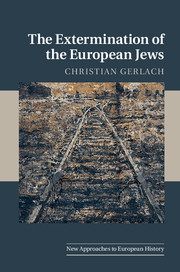Book contents
- Frontmatter
- Contents
- List of tables
- Acknowledgments
- List of abbreviations
- 1 Introduction
- Part I Persecution by Germans
- 2 Before 1933
- 3 From enforced emigration to territorial schemes: 1933–41
- 4 From mass murder to comprehensive annihilation: 1941–42
- 5 Extending mass destruction: 1942–45
- 6 Structures and agents of violence
- Part II Logics of persecution
- Part III The European dimension
- Bibliography
- Index
5 - Extending mass destruction: 1942–45
from Part I - Persecution by Germans
Published online by Cambridge University Press: 05 March 2016
- Frontmatter
- Contents
- List of tables
- Acknowledgments
- List of abbreviations
- 1 Introduction
- Part I Persecution by Germans
- 2 Before 1933
- 3 From enforced emigration to territorial schemes: 1933–41
- 4 From mass murder to comprehensive annihilation: 1941–42
- 5 Extending mass destruction: 1942–45
- 6 Structures and agents of violence
- Part II Logics of persecution
- Part III The European dimension
- Bibliography
- Index
Summary
As described in Chapter 4, Hitler had decided in principle in December 1941 to kill the Jews in Europe, Göring had given the matter urgency in August 1942, and by June 1942 Himmler had adopted a plan to murder all of the Jews within one year, i.e., by the middle of 1943. But none of this meant that annihilation would run automatically or smoothly. Further mass murders required new impulses and institutional support based on the views and interests of German functionaries. They also needed the consent of foreign governments, bureaucracies and, to a certain extent, populations. Moreover, in the second half of World War II, Germany occupied one friendly country after the other in order to prevent them from switching sides, and this brought new Jewish communities under more direct German control. This expanded and prolonged efforts aimed at the extermination of Jews, with greatly varying outcomes.
By the end of 1942, the great majority of Jews within the German sphere of influence had been murdered. About 4.5 million were dead, about 1.1 million lived in German-occupied countries (primarily Poland and France), and some 1.2 million others lived in countries allied with Germany but not occupied (above all, Hungary and Romania). About 3 million Jews perished from May to December 1942, 2 million in the four horrible months from July to October 1942 alone.
This chapter provides a survey of the major mass murders of the second half of World War II, and is based on the assumption that they did not happen randomly. Rather, the places and times of their occurrence were the result of certain political groups, and their considerations, winning the upper hand over other groups and considerations. The fact that the pace of mass murder clearly slowed after the end of 1942 was also due to a number of political factors. In German-occupied countries without dependent national governments, the German demand for Jewish labor decelerated the destruction. In several countries with a national government, whether under German occupation or not, the readiness of regimes, non-German administrations and local non-state actors to hand over their Jewish compatriots decreased considerably. Such reluctance had already begun to develop between August and November 1942, most notably, and in remarkably parallel fashion, in Romania, Italy, France and Slovakia – but also, to a certain degree, in occupied Poland, though for other reasons.
- Type
- Chapter
- Information
- The Extermination of the European Jews , pp. 100 - 118Publisher: Cambridge University PressPrint publication year: 2016



